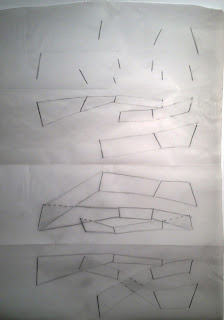After discussion with my tutor, and suggestions of projects to look at, I became very interested and inspired by the forms of OAB, in particular the Barcelona Botanical Gardens and the Fitness Center, headed by Carlos Ferrater. His approach to the integration of landscape and architecture is so beautiful and seamless, entwining pathways, whilst holding back and manipulating the landscape with the blade walls that hold back the fall of the site. In the Barcelona Botanical Gardens, the natural contours are still retained, whilst small moments are revealed where the ground is peeled back and flat landings ensnare walkers by to stand and pause to appreciate the design.
I then experimented with the effects of three different forms on the Coal Loader Platform; a Transitional piece, a Landscape piece and a Pavilion piece. Their framing of the site and the circulation provided when the walls are simplified provides a diagrammatic analysis, from which I can further my experiments of the site.
Investigation - Experimental Process
From my initial concepts of blade walls, and the ideas of landscaping, I felt that there was something missing from the Coal Loader site. By the industrial installation of the Coal Loader platform, flattening the ground and composing a rigid sandstone box, it felt like it had been stripped of nature. By that I mean that the natural landscape had been violated, defected and there was a heavy void which should otherwise be falling to the sea.
I wanted to bring back the slope, the pre-existing environment that was there before the industrial development almost 100 years ago. This was more than just an aesthetic decision, resting on the morals of what is right as an architect to interpret the site, the client and to provide the existing surroundings with a contextual link to either its history or its future.
Graphically, I started by re-placing the contour lines on the Coal Loader that it had stripped the site of. It was not a hard task; by analysing the contours of the site plan, it was clear to see the gradient and relief.
After that, I identified points of interest, where the contours bunched up, or changed direction in succession, and ultimately, moments where the landscape would be special disregarding the Platform. These moments of interest are represented as lines, in the direction of their grade, and the length is representative of the extent of the moment.
With these points of interest, I could then begin creating geometric forms, drawing links between the lines.
Next was the conception of these geometric shapes as spaces, both negative and positive. Following, I created a diagram of the tectonic shift of these spaces, causing vaults up and down, so that they were always rising and dipping along the fault lines.
With the initial process drawn up, I began conception of a 3D model to understand it further. I created the fault line along the common points of the geometric shapes, to develop something I could play with.
It then became a more flexible model, in paper so that I could manipulate and play with the rises and falls that were created by the split in the 'landscape'.
The final part of the process was to redraw, with the interpretations made of the 3D model. I wanted to conceive spaces where a walkway weaved in between the extruded forms.
After I reached the end of the process, I came to the conclusion that it provided me with the right direction; that of a form derived from the landscape, reflects it, but also creates an interesting effect of contrast; seclusion into the voids and spaces created by the protrusions, and also the openness that was provided by the walkways opportunity to breathe the wide open spaces. I did, however, find it a primitive and restrictive iteration. So, using the same points of interest, which I will now refer to as 'blades', I began experimenting with the countless combinations of geometric links that were possible, as I knew with this trial and error, I could find an origin with which I could develop a much stronger scheme, with more opportunity to rise and fall in relation to the site, whilst providing harbours and much more complex space.
Different iterations of geometric form, starting with simple, disassociated shapes, and moving to more intertwined, complex geometries.
It was through this process that I was able to analyse the options for the opportunity they provided. I wanted some level of overlapping as this would reflect the cascading effect of the landscape falling away. More separate forms meant more level changes, whilst too many tended to develop singular spaces which had no connection. It was better that they were more extreme in their angles, as this would eventually form the peeling back of the ground to create spaces that are more dramatic and provide a sense of shelter and retainment from the fall of the site.
I then decided to do the same process for the upper site, as I felt it would be much more sensible and logical to create a unified theme throughout the project, rather than two separate themes that divide the site and cause a disparity.
Concept Sketches.
Ideas of spaces resting in the landscape. I wanted to see how a form could sit either in the landscape, or be situated on top, as a floating box levitated on the blade wall.
opportunities for the landscape to peel back and integrate with structures.
The different opportunities present with the landscaping ideas.
Terracing of structures on the hillside of the upper site.





.JPG)
















Pulchinenoside A3 is extracted from the roots of Pulsatilla chinensis. It is an attractive candidate for further development as a cognitive enhancer capable of alleviating memory dysfunctions associated with aging and neurodegenerative diseases. Anemoside A3
ReplyDelete